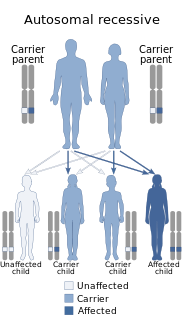Interferon regulatory factor 6 also known as IRF6 is a protein that in humans is encoded by the IRF6 gene. [5]
Interferon regulatory factor 6 also known as IRF6 is a protein that in humans is encoded by the IRF6 gene. [5]
This gene encodes a member of the interferon regulatory transcription factor (IRF) family. Family members share a highly conserved N-terminal helix-turn-helix DNA-binding domain and a less conserved C-terminal protein-binding domain. [6] The function of IRF6 is related to the formation of connective tissue, for example that of the palate. [7] This gene encodes a member of the interferon regulatory transcription factor (IRF) family. In addition, it has been observed that IRF6 gene is under epigenetic regulation by promoter methylation. [8]
A mutation of the IRF6 gene can lead to the autosomal dominant van der Woude syndrome (VWS) [9] or the related popliteal pterygium syndrome (PPS). [10] Van der Woude syndrome can include cleft lip and palate features along with dental anomalies and lip fistulas. In addition, common alleles in IRF6 have also been associated with non-syndromic cases of cleft lip and/or palate through genome-wide association studies and in many candidate gene studies. [11] These disorders are caused by mutations in the IRF6 gene and some of the phenotypic heterogeneity is due to different types of IRF6 mutations. [5] One explanation for this phenotypic variation between syndromes is based on a differential impact on the structure of the dimerized mutant proteins. VWS mutations appear to result in haploinsufficiency while PPS mutations may be dominant negative in nature. [12] The spectrum of mutations in VWS and PPS has been recently summarized. [13] IRF6 has been shown to play a critical role in keratinocyte development. [14] [15] A role for IRF6 in the common forms of cleft lip and palate has also been demonstrated [16] and may explain ~20% of cases of cleft lip only. [17] Variants in IRF6 have yielded consistent evidence of association with syndromic cleft and/or palate across multiple studies. A study by Birnbaum and colleagues in 2009 confirmed the impact of this gene on the etiology of cleft lip and/or palate, and the GENEVA Cleft Consortium study, which studied families from multiple populations, reconfirmed the findings that IRF6 mutations are strongly associated with cleft and/or palate. A role of IRF6 in causing cleft lip and/or palate is further supported by analysis of IRF6 mutant mice which exhibit a hyper-proliferative epidermis that fails to undergo terminal differentiation, leading to multiple epithelial adhesions that can occlude the oral cavity and result in cleft palate. Research on animal models indicate IRF6 determines keratinocyte proliferation and also has a key role in the formation of oral periderm. Recently, through utilization of mouse genetics, gene expression analyses, chromatin immunoprecipitation studies and luciferase reporter assays, it has been shown that IRF6 is a direct target of p63, which underlies several malformation syndromes that include cleft features, and p63 activates IRF6 transcription through the IRF6 enhancer element. Variation in the enhancer element increases susceptibility to cleft lip only. Both cleft lip with or without a cleft palate and cleft palate only features have been seen in families with an IRF6 mutation. In addition, different types of clefts can segregate within the same family. [11]
The IRF6 aberrant promoter DNA hypermethylation has been observed associated with cancer onset/progression. Indeed, this improper epigenetic phenomenon has been observed in women affected by Vulvar Squamous cell carcinoma arose from vulver lichen sclerosus. [18] Methylation of the IRF6 promoter may be a marker of cancer risk in patients affected by this disease. [8]
IRF6 gene has been observed progressively downregulated in Human papillomavirus-positive neoplastic keratinocytes derived from uterine cervical preneoplastic lesions at different levels of malignancy. [19] For this reason, this gene is likely to be associated with tumorigenesis and may be a potential prognostic marker for uterine cervical preneoplastic lesions progression. [19] Similarly, IRF6 has been found to be genetically and epigenetically disregulated in Vulvar cancer. [8]

A cleft lip contains an opening in the upper lip that may extend into the nose. The opening may be on one side, both sides, or in the middle. A cleft palate occurs when the palate contains an opening into the nose. The term orofacial cleft refers to either condition or to both occurring together. These disorders can result in feeding problems, speech problems, hearing problems, and frequent ear infections. Less than half the time the condition is associated with other disorders.
Van der Woude syndrome (VDWS) is a genetic disorder characterized by the combination of lower lip pits, cleft lip with or without cleft palate (CL/P), and cleft palate only (CPO). The frequency of orofacial clefts ranges from 1:1000 to 1:500 births worldwide, and there are more than 400 syndromes that involve CL/P. VWS is distinct from other clefting syndromes due to the combination of cleft lip and palate (CLP) and CPO within the same family. Other features frequently associated with VWS include hypodontia in 10-81% of cases, narrow arched palate, congenital heart disease, heart murmur and cerebral abnormalities, syndactyly of the hands, polythelia, ankyloglossia, and adhesions between the upper and lower gum pads.

Popliteal pterygium syndrome (PPS) is an inherited condition affecting the face, limbs, and genitalia. The syndrome goes by a number of names including the popliteal web syndrome and, more inclusively, the facio-genito-popliteal syndrome. The term PPS was coined by Gorlin et al. in 1968 on the basis of the most unusual anomaly, the popliteal pterygium.

Treacle protein is a protein that in humans is encoded by the TCOF1 gene.

Interferon regulatory factors (IRF) are proteins which regulate transcription of interferons. Interferon regulatory factors contain a conserved N-terminal region of about 120 amino acids, which folds into a structure that binds specifically to the IRF-element (IRF-E) motifs, which is located upstream of the interferon genes. Some viruses have evolved defense mechanisms that regulate and interfere with IRF functions to escape the host immune system. For instance, the remaining parts of the interferon regulatory factor sequence vary depending on the precise function of the protein. The Kaposi sarcoma herpesvirus, KSHV, is a cancer virus that encodes four different IRF-like genes; including vIRF1, which is a transforming oncoprotein that inhibits type 1 interferon activity. In addition, the expression of IRF genes is under epigenetic regulation by promoter DNA methylation.

Rosselli–Gulienetti syndrome, also known as Zlotogora–Ogur syndrome and Bowen–Armstrong syndrome, is a type of congenital ectodermal dysplasia syndrome. The syndrome is relatively rare and has only been described in a few cases.

Tumor protein p63, typically referred to as p63, also known as transformation-related protein 63 is a protein that in humans is encoded by the TP63 gene.

Homeobox protein MSX-1, is a protein that in humans is encoded by the MSX1 gene. MSX1 transcripts are not only found in thyrotrope-derived TSH cells, but also in the TtT97 thyrotropic tumor, which is a well differentiated hyperplastic tissue that produces both TSHß- and a-subunits and is responsive to thyroid hormone. MSX1 is also expressed in highly differentiated pituitary cells which until recently was thought to be expressed exclusively during embryogenesis. There is a highly conserved structural organization of the members of the MSX family of genes and their abundant expression at sites of inductive cell–cell interactions in the embryo suggest that they have a pivotal role during early development.

Protein patched homolog 1 is a protein that is the member of the patched family and in humans is encoded by the PTCH1 gene.

Interferon regulatory factor 8 (IRF8) also known as interferon consensus sequence-binding protein (ICSBP), is a protein that in humans is encoded by the IRF8 gene. IRF8 is a transcription factor that plays critical roles in the regulation of lineage commitment and in myeloid cell maturation including the decision for a common myeloid progenitor (CMP) to differentiate into a monocyte precursor cell.

Forkhead box protein E1 is a protein that in humans is encoded by the FOXE1 gene.

Transcription factor AP-2 alpha, also known as TFAP2A, is a protein that in humans is encoded by the TFAP2A gene.

T-box transcription factor TBX22 is a protein that in humans is encoded by the TBX22 gene.

Ventral anterior homeobox 1 is a protein that in humans is encoded by the VAX1 gene.

Miller syndrome, also known as Genée–Wiedemann syndrome, Wildervanck–Smith syndrome or postaxial acrofacial dystosis, is an extremely rare genetic condition that manifests as craniofacial, limb and eye deformities. It is caused by a mutation in the DHODH gene. The incidence of the condition is not known, and nothing is known of its pathogenesis.
A facial cleft is an opening or gap in the face, or a malformation of a part of the face. Facial clefts is a collective term for all sorts of clefts. All structures like bone, soft tissue, skin etc. can be affected. Facial clefts are extremely rare congenital anomalies. There are many variations of a type of clefting and classifications are needed to describe and classify all types of clefting. Facial clefts hardly ever occur isolated; most of the time there is an overlap of adjacent facial clefts.

UPF0739 protein C1orf74 is a protein that in humans is encoded by the C1orf74 gene.

BARX homeobox 1 is a protein that in humans is encoded by the BARX1 gene.
Ankyloblepharon is defined as the adhesion of the edges of the upper eyelid with the lower eyelid. Ankyloblepharon must be differentiated from blepharophimosis, in which palpebral aperture is reduced and there is telecanthus, but the eyelid margins are normal. Another condition similar to ankyloblepharon is symblepharon, in which the palpebral conjunctiva is attached to the bulbar conjunctiva. Recognition of ankyloblepharon necessitates systemic examination to detect associated abnormalities such as genitourinary and cardiac abnormalities and syndactyly.

Adebowale A. Adeyemo is a Nigerian physician-scientist and genetic epidemiologist specialized in genomics and cardiometabolic disorders. He is the deputy director and chief scientific officer of the Center for Research on Genomics and Global Health at the National Human Genome Research Institute.
This article incorporates text from the United States National Library of Medicine, which is in the public domain.